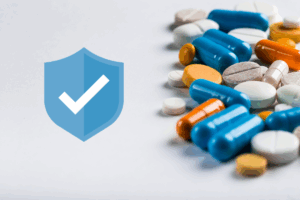National CooperativeRx constantly monitors the pharmaceutical pipeline. As treatment options change, it’s important to know how those changes could impact your plan and which drugs bring the highest value. Our quarterly NCRx Pipeline Reports highlight some of the newest therapies coming to market and are not intended to imply formulary placement or coverage by CVS Caremark.
Convenience, Competition, and a Possible Shift to Medical Benefit in Cholesterol Lowering
Leqvio (inclisiran): A New Year’s Day U.S. Food and Drug Administration (FDA) decision could rock the boat for Repatha® and Praluent®, the two mainstay injectable drugs for lowering cholesterol known as PCSK9 inhibitors. Leqvio® has a different mechanism of action than the PCSK9 inhibitors but has been shown to produce similar LDL lowering of around 50%1. Injection site reactions were more frequent with Leqvio® than placebo but otherwise adverse events between the two groups were similar. Where the drug stands out is in its dosing and administration. It is given in clinics as two starter doses, three months apart, and then every six months thereafter. The PCSK9 inhibitors are injected every two to four weeks by the patient or caregiver. Less frequent dosing with Leqvio® could mean better adherence, and clinic administration could mean the drug may be covered on the medical benefit for many, in contrast to the PCSK9 inhibitors. The drug’s manufacturer is currently working through confirmatory trials to demonstrate a reduction in cardiovascular events for Levqio®, which many agree will increase acceptance by prescribers and allow it to gain up to 30% of the market share by 2025. Meanwhile, Merck is studying an oral version of a PCSK9, MK-0616, which looks promising in phase I trials and would represent a shift back to the pharmacy benefit in this class. However, until phase II and III trials are completed, payers should be prepared for a possible partial shift to the medical benefit in this class of drugs.
Anticipated Launch: January 2022.
Impact: Moderate.
Price: The Institute for Clinical and Economic Review (ICER) has suggested a price of $3,000-$6,000 per year would be cost-effective.
New Spend in Dry Eye Disease Via a Novel Treatment Formulation
Tyrvaya (varenicline): Approved in October, Tyrvaya® became the first treatment for dry eye disease (DED) to be delivered as a nasal spray. It works by activating a nerve pathway that is accessible in the nose and increases tear production. Patients in the drug’s clinical trial “ONSET-1” saw an improvement in their Eye Dryness Score that appears comparable to existing drugs on the market for the condition, such as Xiidra®, CVS’ preferred formulary product.3,4 The drug was well tolerated overall, with sneezing, throat/nasal irritation, and cough as the most frequent side effects in clinical trials. There are many reasons to believe this drug will have a significant impact in the DED market. First, it is thought there are more than 16 million people in the United States living with DED5, and only a small percentage of them are receiving treatment. Second, most patients who receive treatment ultimately abandon therapy due to lack of benefit or side effects, so having more treatment options improves the likelihood of finding a successful therapy. Finally, given that all other products for DED are administered as eye drops, the advantages that come with a nasal spray formulation are sure to be appreciated by patients and prescribers. Patients with significant eye irritation may avoid further aggravating the ocular surface with drops that may sting, and contact lens wearers will not have to remove their lenses to administer drops multiple times per day. Additionally, patients with dexterity or coordination issues may find a nasal spray to be an easier way to administer treatment. Tyrvaya® is currently under New-to-Market Block with CVS, pending review by the Pharmacy and Therapeutics Committee.
Anticipated Launch: Fourth Quarter 2021.
Impact: Moderate. There is a large percentage of untreated DED and a high rate of treatment abandonment, leaving significant potential for any new treatment to be impactful.
Price: $590*/month, which is the same as Xiidra, CVS’ preferred formulary option.
At-Home COVID Treatments: Painful to Pharmacy Spend but May Prove Miraculous to Medical Spend
Paxlovid (nirmatrelvir/ritonavir): Pfizer recently released the final data from its EPIC-HR study on its novel oral treatment for COVID infection in high-risk individuals and received Emergency Use Authorization (EUA) from the FDA. Paxlovid® is a combination product consisting of nirmatrelvir, a protease inhibitor that prevents viral replication inside the cell, combined with ritonavir which serves to prevent degradation of nirmaltrevir by the body. It is dosed twice daily for five days and was extremely effective in preventing hospitalization and death in clinical trials when given within three days of symptom onset. 0.7% of those treated with Paxlovid® were hospitalized (no deaths) while 6.5% of patients in the placebo group were hospitalized and 1.3% died.6 Encouragingly, it still demonstrated robust efficacy when given within five days of symptoms. An additional study is underway to examine Paxlovid’s® ability to prevent hospitalization and death in patients with “standard” risk of severe COVID-19 outcomes. Due to its mechanism of action, the drug has shown to be effective against several key SARS-CoV2 variants, including Omicron. Paxlovid® appears to have a strong safety profile as well, with similar rates of adverse events and therapy discontinuation being similar between treatment and placebo groups; however, Pfizer has not yet published detailed information regarding adverse effects. Importantly, there is no indication that Paxlovid® could cause DNA mutations, which is a theoretical concern for Merck’s molnupiravir. Pfizer plans to price Paxlovid using a tiered approach, with a higher price tag for middle-upper income nations. The U.S. government has a purchase agreement in place for $530 per course of treatment. Despite the major impact Paxlovid® will have on pharmacy spend for payors, the resulting savings in hospitalizations is very likely to make it extremely cost-effective overall.
Anticipated Launch: January 2022.
Impact: High, though supply may hinder use. There are currently only 180,000 treatment courses available, with plans to produce another 80 million by the end of 2022.
Price: $530 per five-day treatment course.
Otezla’s Expanded Approval for Mild Psoriasis Is Sure to Expand Costs as Well
Otezla (apremilast): On December 20, 2021, the FDA expanded approval for Otezla® to use in mild to moderate psoriasis in addition to the existing indication for moderate to severe disease. Otezla® is an oral, non-biologic drug known as a phosphodiesterase 4 inhibitor which works to lower inflammation; it also has indications for treatment of psoriatic arthritis and Bechets Disease, both autoimmune conditions. Until now, treatment of mild to moderate psoriasis centered around topical drugs such as steroids and vitamin D analogs, so having an oral option is a major therapy milestone. Adherence to topical therapies is a significant barrier, and of course topical therapies do little to lower systemic inflammation. In the clinical trial for patients with mild to moderate disease, 21.6% of patients taking Otezla achieved a clinical (Static Physician’s Global Assessment) response compared to 4.1%7 of those taking placebo. The most common side effects of Otezla® are diarrhea, nausea, depression, and suicidal ideation which can be severe and limit use of the drug. The other downside of Otezla for mild psoriasis is cost. While topical treatments can get expensive, none come close to the $4,000 monthly price tag of Otezla; given the large increase in eligible patients with expanded approval, this could mean a significant increase in the cost of treatment of mild to moderate psoriasis.
Anticipated Launch: Currently available.
Impact: High. 80% of the 7.5 million people in the United States with psoriasis have mild to moderate disease.8
Price: $4,000* per month.
Other Recent/Pending FDA Approvals
Tezspire (tezepelumab)
Indication: Treatment of severe asthma in patients ages 12+
FDA Approval Date: December 17, 2021.
Cost: Currently unknown.
Comments:
- Approved for severe asthma.
- Cuts flares by 56%.9
- Likely to be priced at parity with others in the class at ~$3,000/month.
- ICER suggests price of $9,000-$12,000/year for cost-effectiveness.
Molnupiravir
Indication: Treatment of COVID-19 in high-risk individuals.
FDA Approval Date: Pending Emergency Use Authorization.
Cost: $700* per treatment course.
Comments:
- Introduces errors into virus’ RNA → “lethal mutagenesis.”
- 30% reduction in hospitalization or death.
- Concern for DNA mutations and safety risks: Cancer, pregnancy loss/birth defects.10
Cortrophin (corticotropin)
Indication: Induction of remission of numerous autoimmune and inflammatory diseases.
FDA Approval Date: November 2021.
Cost: $6,370* per dose, given 1-3 days.
Comments:
- Recent FDA approval for additional indications: Rheumatoid arthritis and multiple sclerosis flare, and nephrotic syndrome.
- Already approved for numerous autoimmune and inflammatory conditions.
- Important therapy for steroid-resistant patients.
Rinvoq (upadacitanib)
Indication: Psoriatic arthritis.
FDA Approval Date: December 2021.
Cost: $5,100* per month.
Comments:
- Approved for use after failure with TNF alpha inhibitor, such as Humira®, though likely will be used as third or fourth-line treatment given safety concerns.
- Janus kinase inhibitors (JAK) such as Rinvoq® come with FDA warnings regarding possible risk of blood clots, heart events, and cancer.
- FDA decision pending for use in atopic dermatitis (eczema) as well.
Cyclosporine ophthalmic (generic of Restasis®)
Indication: Dry eye disease.
FDA Approval Date: Pending, likely for 2022.
Cost: Brand Restasis: $615* per month
Comments:
- Multiple companies have submitted applications to FDA for generic product but all failed due to Restasis’ unique formulation.
- Will likely be approved as an authorized generic, which tend to offer little savings.
Lacosamide (generic of Vimpat®)
Indication: Seizure disorders.
FDA Approval Date: Pending for March 2022.
Cost: Likely more than 90% savings off of brand. One month supply of brand costs up to $1,800*.
Comments:
- Multiple generic manufacturers expected at launch.
- More than 90% savings off of brand price expected (one month supply of brand currently costs up to $1,800*).
- Resulting generic savings will be significant.
Teriperatide (generic of Forteo®)
Indication: Osteoporosis.
FDA Approval Date: Teva 2021; others in 2022.
Cost: Forteo brand: $1,600* per month.
Comments:
- Teva likely to gain 180-day exclusivity, which will mean little savings at first.
- As other manufacturers launch, may see price erosion.
- Bonsity, another teriperatide product, has submitted data for therapeutic equivalence. If approved, may see additional savings from increased competition.
*Wholesale acquisition cost
- Ray K, Wright R, Kallend D, et al. Two Phase 3 Trials of Inclisiran in Patients with Elevated LDL Cholesterol. N Engl J Med. 2020;382(16):1507-1519
- Lin GA, Kazi DS, Jih J, Agboola F, Chapman R, Pearson SD. Inclisiran and bempedoic acid for patients with heterozygous familial hypercholesterolemia and for secondary prevention of ASCVD: Effectiveness and value; final evidence report. Institute for Clinical and Economic Review, March 2, 2021.
- Oyster Point Pharma announces FDA approval of TYRVAYA™ (varenicline solution) nasal spray for the treatment of the signs and symptoms of dry eye disease. Available at https://investors.oysterpointrx.com/node/7916/pdf. Accessed December 20, 2021.
- Holland EJ, Luchs J, Karpecki PM, et al. Lifitegrast for the treatment of dry eye disease: results of a phase III, randomized, double-masked, placebo-controlled trial (OPUS-3). Ophthalmology 2017 Jan;124(1):53-60.
- Dalton, M. Understanding prevalence, demographics of dry eye disease. Ophthalmology Times 2019 Jul. Available at https://www.ophthalmologytimes.com/view/understanding-prevalence-demographics-dry-eye-disease. Accessed December 20, 2021.
- Pfizer Announces Additional Phase 2/3 Study Results Confirming Robust Efficacy of Novel COVID-19 Oral Antiviral Treatment Candidate in Reducing Risk of Hospitalization or Death. Available at https://www.pfizer.com/news/press-release/press-release-detail/pfizer-announces-additional-phase-23-study-results. Accessed December 21, 2021.
- FDA approves Otezla® (apremilast) for the treatment of adult patients with plaque psoriasis, regardless of severity level. Available at https://wwwext.amgen.com/newsroom/press-releases/2021/12/fda-approves-otezla-apremilast-for-the-treatment-of-adult-patients-with-plaque-psoriasis-regardless-of-severity-level. Accessed December 22, 2021.
- Menter A, Gottlieb A, Feldman SR, Van Voorhees AS et al. Guidelines of care for the management of psoriasis and psoriatic arthritis: Section 1. Overview of psoriasis and guidelines of care for the treatment of psoriasis with biologics. J Am Acad Dermatol 2008 May;58(5):826-50.
- Menzies-Gow A, Corren J, Bourdin A. Tezepelumab in adults and adolescents with severe, uncontrolled asthma. N Engl J Med. 2021; 384(19); 1800-1809.
- Zhou S, Hill CS, Sarkar S, et al. β-D-N4-hydroxycytidine inhibits SARS-CoV-2 through lethal mutagenesis but is also mutagenic to mammalian cells. J Infect Dis 2021 August; 224(3): 415–19.




